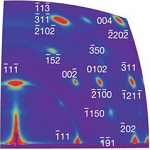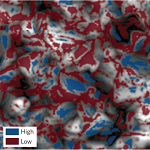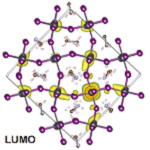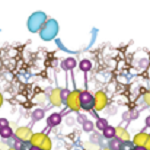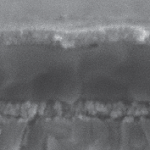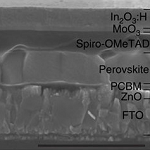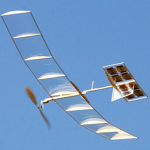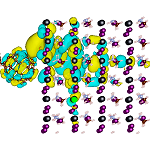Solar energy
Atomic-level passivation mechanism of ammonium salts enabling highly efficient perovskite solar cells
Essa A. Alharbi et al., Nat. Commun., 10, 3008 (2019) doi:10.1038/s41467-019-10985-5
 Various approaches have been developed to push higher the efficiency of halide perovskite solar cells. Here Alharbi et al. show that ammonium salts treatment can reduce the defect density at the perovskite surface and understand the passivation mechanism with 2D-solid state NMR.
Various approaches have been developed to push higher the efficiency of halide perovskite solar cells. Here Alharbi et al. show that ammonium salts treatment can reduce the defect density at the perovskite surface and understand the passivation mechanism with 2D-solid state NMR.
Planar perovskite solar cells with long-term stability using ionic liquid additives
Sai Bai et al., Nature, 571, 245–250 (2019) doi:10.1038/s41586-019-1357-2
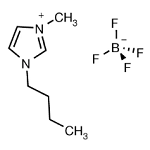 The rapid rise in power conversion efficiencies for hybrid perovskite solar cells towards those of silicon solar cells has led many to speculate on whether such devices could eventually compete with silicon PV in the market. However, the instability of the hybrid perovskite absorber layer to light, heat, humidity is a serious barrier. Various approaches, including cation substitution, surface treatments and additives, have been used to improve device stability; now Henry Snaith and colleagues have developed an ionic liquid (BMIMBF4) additive approach to improve stability of both unencapsulated and encapsulated planar devices under light soaking conditions. Shareable link
The rapid rise in power conversion efficiencies for hybrid perovskite solar cells towards those of silicon solar cells has led many to speculate on whether such devices could eventually compete with silicon PV in the market. However, the instability of the hybrid perovskite absorber layer to light, heat, humidity is a serious barrier. Various approaches, including cation substitution, surface treatments and additives, have been used to improve device stability; now Henry Snaith and colleagues have developed an ionic liquid (BMIMBF4) additive approach to improve stability of both unencapsulated and encapsulated planar devices under light soaking conditions. Shareable link
High efficiency perovskite quantum dot solar cells with charge separating heterostructure
Qian Zhao et al., Nat. Commun., 4, 2842 (2019) doi:10.1038/s41467-019-10856-z
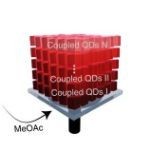 Metal halide perovskites have wide tunability in both material and device structure. Here Zhao et al. fabricate heterojunctions of colloidal perovskite quantum dots with different composition using layer-by-layer deposition and demonstrate improved photovoltaic performance with enhanced photocarrier harvesting.
Metal halide perovskites have wide tunability in both material and device structure. Here Zhao et al. fabricate heterojunctions of colloidal perovskite quantum dots with different composition using layer-by-layer deposition and demonstrate improved photovoltaic performance with enhanced photocarrier harvesting.
Reduction of lead leakage from damaged lead halide perovskite solar modules using self-healing polymer-based encapsulation
Yan Jianget al., Nat. Energy, 4, 585–593 (2019) doi:10.1038/s41560-019-0406-2
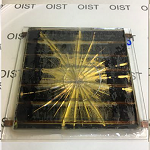 Lead leakage from damaged perovskite solar cells poses a challenge to the deployment of such technology. Here, Jiang, Qiu and co-workers quantify lead leakage caused by a simulated hail impact under a number of weather conditions and show that self-healing encapsulations can effectively reduce it. Shareable link
Lead leakage from damaged perovskite solar cells poses a challenge to the deployment of such technology. Here, Jiang, Qiu and co-workers quantify lead leakage caused by a simulated hail impact under a number of weather conditions and show that self-healing encapsulations can effectively reduce it. Shareable link
Performance of perovskite solar cells under simulated temperature-illumination real-world operating conditions
Wolfgang Tress et al., Nat. Energy, 4, 568–574 (2019) doi:10.1038/s41560-019-0400-8
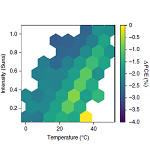 Real-world conditions under which solar cells operate can be different from standard testing conditions. Tress et al. investigate the effects of temperature and irradiation on the performance of a perovskite cell and a reference silicon cell, reproducing real weather conditions in the laboratory. Shareable link
Real-world conditions under which solar cells operate can be different from standard testing conditions. Tress et al. investigate the effects of temperature and irradiation on the performance of a perovskite cell and a reference silicon cell, reproducing real weather conditions in the laboratory. Shareable link
Controlling competing photochemical reactions stabilizes perovskite solar cells
Silvia Motti et al., Nat. Photon., 13, 532–539 (2019) doi:10.1038/s41566-019-0435-1
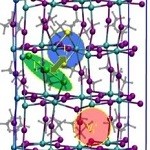
Cation and anion immobilization through chemical bonding enhancement with fluorides for stable halide perovskite solar cells
Nengxu Li et al., Nat. Energy, 4, 408–415 (2019) doi:10.1038/s41560-019-0382-6
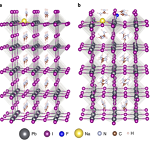 Defects and defect migration are detrimental for perovskite solar cell efficiency and long-term stability. Li et al. show that fluoride is able to suppress the formation of halide anion and organic cation vacancy defects by restraining the relative ions via ionic and hydrogen bonds. Shareable link
Defects and defect migration are detrimental for perovskite solar cell efficiency and long-term stability. Li et al. show that fluoride is able to suppress the formation of halide anion and organic cation vacancy defects by restraining the relative ions via ionic and hydrogen bonds. Shareable link
Surface passivation of perovskite film for efficient solar cells
Qi Jiang et al., Nat. Photon., 13, 460–466 (2019) doi:10.1038/s41566-019-0398-2
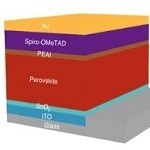
Efficient, stable and scalable perovskite solar cells using poly(3-hexylthiophene)
Eui Hyuk Jung et al., Nature, 567, 511–515 (2019) doi:10.1038/s41586-019-1036-3
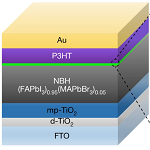 Poly(3-hexylthiophene-2,5-diyl) (P3HT) is a much-loved and much-used stalwart of the semiconducting polymer family. It is used extensively in blends for organic solar cells, but thus far attempts to put it to use as a hole transport material for hybrid perovskite solar cells have resulted in performances well below devices that use spiroOMeTAD, which is expensive and requires dopants. Now, Jangwon Seo and colleagues have developed a deposition approach for hybrid perovksites that results in a double layer of halide perovskite. The top layer of the halide perovskite induces a fibrillar morphology of the top-deposited P3HT and results in greatly improved efficiencies and stabilities to light soaking. Shareable link
Poly(3-hexylthiophene-2,5-diyl) (P3HT) is a much-loved and much-used stalwart of the semiconducting polymer family. It is used extensively in blends for organic solar cells, but thus far attempts to put it to use as a hole transport material for hybrid perovskite solar cells have resulted in performances well below devices that use spiroOMeTAD, which is expensive and requires dopants. Now, Jangwon Seo and colleagues have developed a deposition approach for hybrid perovksites that results in a double layer of halide perovskite. The top layer of the halide perovskite induces a fibrillar morphology of the top-deposited P3HT and results in greatly improved efficiencies and stabilities to light soaking. Shareable link
Highly stable and efficient all-inorganic lead-free perovskite solar cells with native-oxide passivation
Min Chen et al., Nat. Commun., 10, 16 (2019) doi:10.1038/s41467-018-07951-y
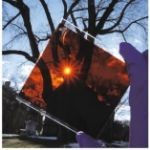 Replacing the toxic lead in the state-of-the-art halide perovskite solar cells is highly desired but the device performance and stability are usually compromised. Here Chen et al. develop inorganic cesium tin and germanium mixed perovskites that show high operational stability and efficiency of 7%.
Replacing the toxic lead in the state-of-the-art halide perovskite solar cells is highly desired but the device performance and stability are usually compromised. Here Chen et al. develop inorganic cesium tin and germanium mixed perovskites that show high operational stability and efficiency of 7%.
Efficient two-terminal all-perovskite tandem solar cells enabled by high-quality low-bandgap absorber layers
Dewei Zhao et al., Nat. Energy, 3, 1093–1100 (2018) doi:10.1038/s41560-018-0278-x
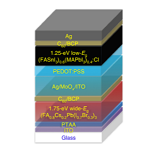 Two-terminal monolithic all-perovskite tandem solar cells are attractive due to their flexible nature and low-cost fabrication. Here the authors develop a process to obtain high-quality Sn–Pb perovskite thin films by incorporating chlorine. Such layers are employed to fabricate 20.7%-efficient tandem cells with 80 h operational stability. Shareable link
Two-terminal monolithic all-perovskite tandem solar cells are attractive due to their flexible nature and low-cost fabrication. Here the authors develop a process to obtain high-quality Sn–Pb perovskite thin films by incorporating chlorine. Such layers are employed to fabricate 20.7%-efficient tandem cells with 80 h operational stability. Shareable link
From the archive
High irradiance performance of metal halide perovskites for concentrator photovoltaics
Zhiping Wang et al., Nat. Energy, 3, 855–861 (2018) doi:10.1038/s41560-018-0220-2
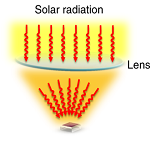 Metal halide perovskites offer the potential for high-efficiency, low-fabrication-cost solar cells. This study now explores their prospects if deployed in concentrator photovoltaics and finds they perform well up to a concentration of 53 Suns and retain good stability under 10 Suns for over 150 h. Shareable link
Metal halide perovskites offer the potential for high-efficiency, low-fabrication-cost solar cells. This study now explores their prospects if deployed in concentrator photovoltaics and finds they perform well up to a concentration of 53 Suns and retain good stability under 10 Suns for over 150 h. Shareable link
Visualization and suppression of interfacial recombination for high-efficiency large-area pin perovskite solar cells
Martin Stolterfoht et al., Nat. Energy, 3, 847–854 (2018) doi:10.1038/s41560-018-0219-8
 Non-radiative recombination is a critical limiting factor for perovskite solar cell performance. Stolterfoht et al. visualize the various recombination pathways in planar pin cells with photoluminescence imaging and use it to design improved solar cells with 1 cm2 areas and ~20% efficiency. Shareable link
Non-radiative recombination is a critical limiting factor for perovskite solar cell performance. Stolterfoht et al. visualize the various recombination pathways in planar pin cells with photoluminescence imaging and use it to design improved solar cells with 1 cm2 areas and ~20% efficiency. Shareable link
Suppression of atomic vacancies via incorporation of isovalent small ions to increase the stability of halide perovskite solar cells in ambient air
Makhsud I. Saidaminov et al., Nat. Energy, 3, 648-654 (2018) doi:10.1038/s41560-018-0192-2
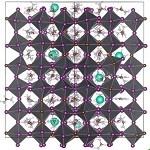 Despite their high efficiencies, perovskite solar cells still suffer from degradation issues that impede their practical deployment. Saidaminov et al. explore the effect of local lattice strain on vacancy formation and show that careful choice of dopants plays a key role, enhancing the device stability. Shareable link
Despite their high efficiencies, perovskite solar cells still suffer from degradation issues that impede their practical deployment. Saidaminov et al. explore the effect of local lattice strain on vacancy formation and show that careful choice of dopants plays a key role, enhancing the device stability. Shareable link
Fully textured monolithic perovskite/silicon tandem solar cells with 25.2% power conversion efficiency
Florent Sahli et al., Nat. Mater., 17, 820-826 (2018) doi:10.1038/s41563-018-0115-4

Solvent-controlled growth of inorganic perovskite films in dry environment for efficient and stable solar cells
Pengyang Wang et al., Nat. Commun., 9, 2225 (2018) doi:10.1038/s41467-018-04636-4
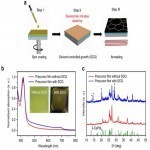 Cesium lead iodide inorganic perovskite solar cells have great potential but the phase instability hinders their development. Here Wang et al. show a controlled drying process to make phase stable and highly efficient solar cells with power conversion efficiency of 15.7%.
Cesium lead iodide inorganic perovskite solar cells have great potential but the phase instability hinders their development. Here Wang et al. show a controlled drying process to make phase stable and highly efficient solar cells with power conversion efficiency of 15.7%.
Molecular doping enabled scalable blading of efficient hole-transport-layer-free perovskite solar cells
Wu-Qiang Wu et al., Nat. Commun., 9, 1625 (2018) doi:10.1038/s41467-018-04028-8
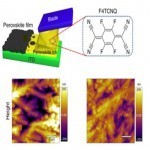 The existing hole-transporting materials cause problems in the cost and scalability of the perovskite solar cells. Here Wu et al. fabricate high efficiency cells by molecularly doping the perovskite layer without using hole-transporting layers, thus simplify the device architecture and processing steps.
The existing hole-transporting materials cause problems in the cost and scalability of the perovskite solar cells. Here Wu et al. fabricate high efficiency cells by molecularly doping the perovskite layer without using hole-transporting layers, thus simplify the device architecture and processing steps.
Thermochromic halide perovskite solar cells
Jia Lin et al., Nat. Mater., 17, 261-267 (2018) doi:10.1038/s41563-017-0006-0
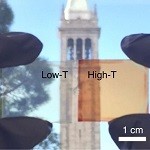
Tailored interfaces of unencapsulated perovskite solar cells for >1,000 hour operational stability
Jeffrey A. Christians et al., Nat. Energy, 3, 68-74 (2018) doi:10.1038/s41560-017-0067-y
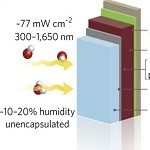 The stability of perovskite solar cells depends on each layer and interface in the device. Here, Christians et al. systematically design the entire device stack focusing on stability, creating cells that retain 88% of their initial efficiency on average, after 1,000 h of unencapsulated operation. Shareable link
The stability of perovskite solar cells depends on each layer and interface in the device. Here, Christians et al. systematically design the entire device stack focusing on stability, creating cells that retain 88% of their initial efficiency on average, after 1,000 h of unencapsulated operation. Shareable link
Systematic investigation of the impact of operation conditions on the degradation behaviour of perovskite solar cells
Konrad Domanski et al., Nat. Energy, 3, 61-67 (2018) doi:10.1038/s41560-017-0060-5
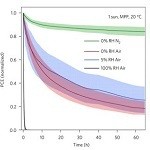 Perovskite solar cells suffer from poor operational stability. Stability measurement conditions used in various studies differ widely. Here, Domanski et al. systematically study environmentally induced degradation in an effort to drive the community towards a consensus on how to age perovskite solar cells. Shareable link
Perovskite solar cells suffer from poor operational stability. Stability measurement conditions used in various studies differ widely. Here, Domanski et al. systematically study environmentally induced degradation in an effort to drive the community towards a consensus on how to age perovskite solar cells. Shareable link
Efficient ambient-air-stable solar cells with 2D–3D heterostructured butylammonium-caesium-formamidinium lead halide perovskites
Zhiping Wang et al., Nat. Energy, 6, 17135 (2017) doi:10.1038/nenergy.2017.135
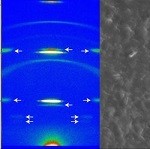 Various strategies are developed to combine high efficiency and stability in perovskite solar cells. Here, Wang et al. mix 2D and 3D mixed-cation and mixed-halide perovskite phases in solar cells with stabilized efficiencies up to 19.5% and improved stability under full illumination and ambient air. Shareable link
Various strategies are developed to combine high efficiency and stability in perovskite solar cells. Here, Wang et al. mix 2D and 3D mixed-cation and mixed-halide perovskite phases in solar cells with stabilized efficiencies up to 19.5% and improved stability under full illumination and ambient air. Shareable link
One-year stable perovskite solar cells by 2D/3D interface engineering
Giulia Grancini et al., Nat. Commun. 8 15684 (2017) doi:10.1038/ncomms15684
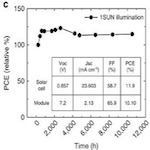 Up-scaling represents a key challenge for photovoltaics based on metal halide perovskites. Using a composite of 2D and 3D perovskites in combination with a printable carbon black/graphite counter electrode, Grancini et al., report 11.2% efficient modules stable over 10,000 hours.
Up-scaling represents a key challenge for photovoltaics based on metal halide perovskites. Using a composite of 2D and 3D perovskites in combination with a printable carbon black/graphite counter electrode, Grancini et al., report 11.2% efficient modules stable over 10,000 hours.
Diffusion engineering of ions and charge carriers for stable efficient perovskite solar cells
Enbing Bi et al., Nat. Commun. 8, 15330 (2017) doi:10.1038/ncomms15330
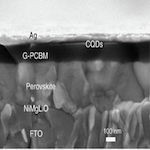 Ion migration in perovskite solar cells are known to cause hysteresis and instability. Bi et al., report a charge extraction layer based on graphene, fullerenes and carbon quantum dots which suppresses ion diffusion and enhances charge carrier diffusion leading to efficient devices with improved stability.
Ion migration in perovskite solar cells are known to cause hysteresis and instability. Bi et al., report a charge extraction layer based on graphene, fullerenes and carbon quantum dots which suppresses ion diffusion and enhances charge carrier diffusion leading to efficient devices with improved stability.
Low-Bandgap Mixed Tin–Lead Iodide Perovskite Absorbers with Long Carrier Lifetimes for All-Perovskite Tandem Solar Cells
Dewei Zhao et al., Nat. Energy 2, 17018 (2017) doi:10.1038/nenergy.2017.18
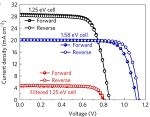 All-perovskite tandem solar cells hold the promise of high efficiencies whilst safeguarding the ease of fabrication intrinsic to perovskites. Here, Zhao et al. present a certified 17% efficient tin and lead perovskite solar cell, which is integrated as the low-bandgap component of a tandem device with 21% efficiency. Shareable link
All-perovskite tandem solar cells hold the promise of high efficiencies whilst safeguarding the ease of fabrication intrinsic to perovskites. Here, Zhao et al. present a certified 17% efficient tin and lead perovskite solar cell, which is integrated as the low-bandgap component of a tandem device with 21% efficiency. Shareable link
23.6%-efficient monolithic perovskite/silicon tandem solar cells with improved stability
Kevin A. Bush et al., Nat. Energy, 2, 17009 (2017) doi:10.1038/nenergy.2017.9
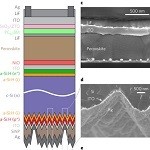 Perovskite solar cells can complement silicon photovoltaics in multijunction devices. Here, the authors optimize light harvesting in monolithic perovskite-on-silicon devices and fabricate a certified 23.6% efficient, 1 cm2 tandem solar cell with a perovskite device that withstands damp heat tests. Shareable link
Perovskite solar cells can complement silicon photovoltaics in multijunction devices. Here, the authors optimize light harvesting in monolithic perovskite-on-silicon devices and fabricate a certified 23.6% efficient, 1 cm2 tandem solar cell with a perovskite device that withstands damp heat tests. Shareable link
High-efficiency inverted semi-transparent planar perovskite solar cells in substrate configuration
Fan Fu et al., Nat. Energy 2 16190 (2016) doi:10.1038/nenergy.2016.190
 Perovskite solar cells grown in substrate configuration would open a range of applications, if various challenges could be overcome. Towards that aim, Fu et al. present an architecture allowing inverted semi-transparent planar perovskite solar cells with open-circuit voltage of 1.116 V and 16.1% efficiency. Shareable link
Perovskite solar cells grown in substrate configuration would open a range of applications, if various challenges could be overcome. Towards that aim, Fu et al. present an architecture allowing inverted semi-transparent planar perovskite solar cells with open-circuit voltage of 1.116 V and 16.1% efficiency. Shareable link
Photocatalytic hydrogen generation from hydriodic acid using methylammonium lead iodide in dynamic equilibrium with aqueous solution
Sunghak Park et al., Nat. Energy 2, 16185 (2016) doi:10.1038/nenergy.2016.185
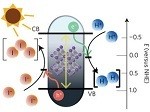 Organometal halide perovskite materials have been the subject of intensive research efforts in the context of photovoltaic applications. Here the authors exploit dynamic equilibrium to photocatalytically generate hydrogen from aqueous HI solutions using methylammonium lead iodide. Shareable link
Organometal halide perovskite materials have been the subject of intensive research efforts in the context of photovoltaic applications. Here the authors exploit dynamic equilibrium to photocatalytically generate hydrogen from aqueous HI solutions using methylammonium lead iodide. Shareable link
Enhanced efficiency and exceptional stability in hole-transport layer free CsSnI3 perovskite photovoltaics
K. P. Marshall et al., Nat. Energy, 1, 16178 (2016) doi:10.1038/nenergy.2016.178
 Tin-based photovoltaic devices are less toxic than their lead-based counterparts, but suffer severe stability issues due to the susceptibility of tin oxidation. Here the authors report a CsSnI3 perovskite solar cell with a SnCl2 additive that displays a remarkable stability. Shareable link
Tin-based photovoltaic devices are less toxic than their lead-based counterparts, but suffer severe stability issues due to the susceptibility of tin oxidation. Here the authors report a CsSnI3 perovskite solar cell with a SnCl2 additive that displays a remarkable stability. Shareable link
Perovskite solar cells with 18.21% efficiency and area over 1 cm2 fabricated by heterojunction engineering
Yongzhen Wu et al., Nat. Energy 1, 16148 (2017) doi:10.1038/nenergy.2016.148
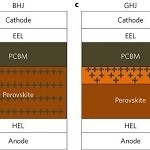 The performance of inverted perovskite solar cells has so far lagged behind that of their normal-structure counterparts. Wu et al. fabricate an inverted perovskite–fullerene solar cell with a graded heterojunction that achieves a certified efficiency of over 18% for a cell area of 1 cm2. Shareable link
The performance of inverted perovskite solar cells has so far lagged behind that of their normal-structure counterparts. Wu et al. fabricate an inverted perovskite–fullerene solar cell with a graded heterojunction that achieves a certified efficiency of over 18% for a cell area of 1 cm2. Shareable link
High-efficiency two-dimensional Ruddlesden–Popper perovskite solar cells
Hsinhan Tsan et al., Nature 536, 512-516 (2016) doi:10.1038/nature18306
Thin-film solar cells were fabricated using layered two-dimensional perovskites with near-single-crystalline out-of-plane alignment, which facilitates efficient charge transport leading to greatly improved power conversion efficiency with technologically relevant stability to light exposure, humidity and heat stress. Shareable link
Facet-dependent photovoltaic efficiency variations in single grains of hybrid halide perovskite
Sibel Y. Leblebici et al., Nat. Energy 1, 16093 (2016) doi:10.1038/nenergy.2016.93
The photovoltaic properties of hybrid organic-inorganic perovskites are sensitive to the local microstructure, but difficult to quantify at the nanoscale. Leblebici et al. use conductive atomic force microscopy to map the local short circuit current and open circuit voltage, finding heterogeneity within individual grains. Shareable link
Light-activated photocurrent degradation and self-healing in perovskite solar cells
Wanyi Nie et al., Nat. Commun. 7, 11574 (2016) doi:10.1038/ncomms11574
Organometallic perovskite solar cells exhibit good efficiency but their photo-stability is still relatively poorly understood and controlled. Here the authors show that photo-degradation arises from the formation of light-activated meta-stable trap states, is reversible, and can be frozen at 0ºC.
Functionalization of perovskite thin films with moisture-tolerant molecules
Shuang Yang et al., Nat. Energy 1, 15016 (2016), doi:10.1038/nenergy.2015.16
Organic-inorganic perovskites are promising materials for photovoltaic devices, however they have poor tolerance to ambient humidity. It is now shown that their surface can be functionalised with water-resistant molecules to stabilise their performance under humid conditions. Shareable link
Improved air stability of perovskite solar cells via solution-processed metal oxide transport layers
Jingbi You et al., Nat. Nanotechnol. 11, 75-81 (2016) doi:10.1038/nnano.2015.230
Using metal oxides for both the hole- and electron-transport layers in perovskite solar cells significantly improves their stability compared with devices containing organic transport layers. Shareable link
Low-temperature-processed efficient semi-transparent planar perovskite solar cells for bifacial and tandem applications
Fan Fu et al., Nat. Commun. 6, 8932 (2015) doi:10.1038/ncomms9932
Perovskite solar cells already exhibit large efficiencies above 20%. Here, the authors use a low temperature sputtering process to fabricate semi-transparent perovskite solar cells, demonstrating bifacial operation and a 4-terminal tandem with CIGS solar cells surpassing single junction cells.
Flexible high power-per-weight perovskite solar cells with chromium oxide-metal contacts for improved stability in air
Martin Kaltenbrunner et al., Nat. Mater. 14, 1032-1039 (2015) doi:10.1038/nmat4388
The use of a chromium oxide interlayer separating the perovskite film from the metal contacts improves the stability of perovskite solar cells in air. Deposited on thin plastic foils, these ultralight devices power model airplanes and dirigibles. Shareable link
Improved performance and stability of perovskite solar cells by crystal crosslinking with alkylphosphonic acid ω-ammonium chlorides
Xiong Li et al., Nat. Chem. 7, 703-711 (2015) doi:10.1038/nchem.2324
 Perovskite materials show great promise for solar cell devices, owing in particular to their high power conversion efficiency. Now, the addition of butylphosphonic acid 4-ammonium cations during a one-step process has been shown to improve both the efficiency and moisture stability of perovskite photovoltaics, through the formation of hydrogen-bonding crosslinks between neighbouring grains. Shareable link
Perovskite materials show great promise for solar cell devices, owing in particular to their high power conversion efficiency. Now, the addition of butylphosphonic acid 4-ammonium cations during a one-step process has been shown to improve both the efficiency and moisture stability of perovskite photovoltaics, through the formation of hydrogen-bonding crosslinks between neighbouring grains. Shareable link
Perovskite–fullerene hybrid materials suppress hysteresis in planar diodes
Jixian Xu et al., Nat. Commun. 6, 7081 (2015) doi:10.1038/ncomms8081
Metal halide perovskites are promising for solar energy harvesting, but currently prone to a large hysteresis and current instability. Here, Xu et al. show improvements in a hybrid material in which the fullerene is distributed at perovskite grain boundaries and thus passivates defects effectively.


